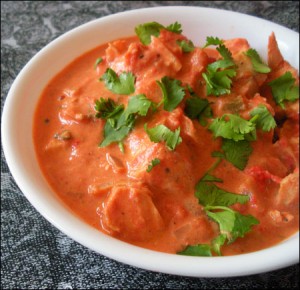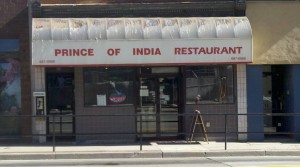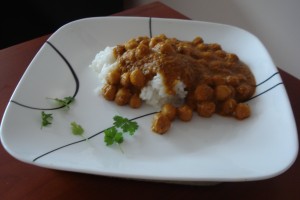I’ve been in something of a recipe rut over this past winter. I couldn’t exactly say why, only that I’ve been uninspired to try new recipes, or even to root through my tried-and-true recipes to resurrect old favorites in the interest of keeping variety in my repertoire. But after a not-so-long, not-so-cold winter of culinary ennui, I have been struck by the urge to cook adventurously again.
And so, I plan to sift through old favorites to post on this blog, as well as to post new recipes as I slake my desire for uncharted culinary horizons. Overblown enough for you? I have a rough goal of trying/posting a new recipes every weekend, or so… though, life happens, so I’m not writing it in stone… only, I suppose, in HTML.
 Bumping around recently on Food.com, I found myself-following a confluence of otherwise unrelated link click-age-intrigued by the concept of a Kofta, or Meatball, curry. Now, “kofta” needn’t mean a meat dish by necessity. I once much enjoyed a Malai Kofta at a Taste of India buffet, and in looking up recipes for such confirmed my memory that it was in fact a non-meat “meatball.” Being unfamiliar with most languages outside Eastern Europe, I could not begin to speculate on the finer nuances of the word “kofta,” but I gather it has a somewhat broader meaning than “meatball” does in American English.
Bumping around recently on Food.com, I found myself-following a confluence of otherwise unrelated link click-age-intrigued by the concept of a Kofta, or Meatball, curry. Now, “kofta” needn’t mean a meat dish by necessity. I once much enjoyed a Malai Kofta at a Taste of India buffet, and in looking up recipes for such confirmed my memory that it was in fact a non-meat “meatball.” Being unfamiliar with most languages outside Eastern Europe, I could not begin to speculate on the finer nuances of the word “kofta,” but I gather it has a somewhat broader meaning than “meatball” does in American English.
Still and all, it would appear that an otherwise un-linguistically-modified “Kofta Curry” would imply meatballs in curry sauce. I hope to explore non-meat koftas at a later time, but in the meantime meatballs seem like an awesome nucleus for curry.
Why do meatballs seem so awesome? Well, I’m always looking for new, cheap and low-carb item to be the crux of curries. I find it often expensive and a bother to keep larger pieces of meat, i.e. chicken breasts, beef steaks, pork loins, etc., stocked regularly at my abode, but vegetables are easy, as are legumes of the ilk of garbanzo beans, and canned fish like salmon or tuna. While I don’t regularly keep ground meat at my apartment, I can’t deny the appeal of a meatball, as the meat is cheap to purchase and interesting things are bound to come of it (since ground meat alone is pretty boring).
On the other hand, I’ve never been especially intrigued by the family of “keema” or loose ground meat curries. But there’s just something about a meatball. Meatballs are one of the few Italian foods I gravitate toward, and so a curry-deserving version of the meatball concept was undeniably appealing.
Without belaboring the point further, I give you my first attempt at kofta curry, starting, of course, with the kofta.
SARAH’S KOFTA
1 teaspoon minced garlic
1 teapsoon ground ginger
2 tablespoons diced onion
1 green chili, diced
2 tablespoons fresh cilantro leaves
1 tablespoon fresh mint leaves
1 egg
1/8 cup plain breadcrumbs
1 lb. ground meat, i.e. beef, turkey, etc.
Combine all ingredients in a food processor, except meat, until well combined. Add meat and process to desired fineness. It appears that kofta recipes tend to favor the more finely ground meats, so don’t be shy about pulverizing it.
Form the meat into roughly golf-sized balls and place in a lightly oiled ceramic or glass pan to bake for about 45 to 1 hour at 300. I would recommend baking until the outside of the meatball is browned and a little crispy.
Having baked the kofta, we need a curry sauce to complement it. I perused a number of kofta curry sauces and formulated a rough consensus of common and appealing ingredients:
SARAH’S KOFTA CURRY SAUCE
vegetable oil
1 large onion, diced
1 teaspoon minced garlic
1 teaspoon ground ginger
1 teaspoon ground coriander seed
1 1/2 teaspoons ground cumin
1/2 teaspoon turmeric
1/2 teaspoon red pepper or paprika
1/2 teaspoon ground cardamom
pinch of ground cloves
1/2 teaspoon ground cinnamon
1 tablespoons ground almonds
1 (15oz) can diced tomatoes in liquid
2 curry leaves or bay leaves
2 tablespoons cream or yogurt
cilantro leaves
Combine everything up to and including the tomatoes in a saucepan or a food processor. If you have an immersion blender, you can saute the ingredients awhile in a saucepan, until the almonds soften, and then pureed them with the blender. Otherwise, combine the ingredients in a food processor first, and then heat in a saucepan. Once pureed, by either method, the curry or bay leaves can be added. Stew awhile longer and then add the cream shortly prior to serving. Garnish with cilantro leaves.
When all was said and done, I was pleased with my kofta, but unenthusiastic about the sauce. I found myself wishing for a sauce that tasted more like a tikka masala or “butter chicken” type sauce. As it was, it seemed to me like the tomatoes and the almonds sort of cancelled each other out, flavor-wise. I went back and reviewed further recipes for kofta curries, and the use both tomatoes and nuts seems pretty standard. Perhaps in the future, I will try using the nuts as a garnish, rather than mixing them in, korma-style, in effort to preserve the tangy-ness of the tomatoes. Then again, maybe I’ll just make tikka masala sauce, instead.









